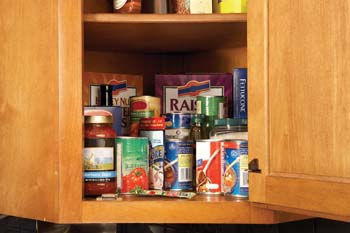For optimum food safety, we need to keep our kitchen clean. Start with the refrigerator freezer, the appliance that works non-stop to keep our perishable foods safely stored. Then tackle kitchen cabinets and pantries, where shelf stable foods are stored. Always wash hands with soap and warm water for 20 seconds before handling food in storage.
Daily refrigerator maintenance makes cleaning easier
- Wipe up refrigerator spills immediately with water and dishwashing liquid, then rinse.
- Make it a habit to check perishable foods daily.
- Cooked leftovers should be consumed or frozen in 3-4 days.
- Check food “use by dates,” and discard if the date has passed.
Keep foods cold while cleaning the refrigerator or freezer
- Keep foods cold in an ice packed cooler.
- Bacteria grow rapidly on foods at room temperature, such as in the kitchen sink or on the countertop.
- Foods held at temperatures above 40 F for more than 2 hours should be discarded.
Thoroughly clean the refrigerator
Clean shelves and drawers
- Remove refrigerator freezer shelves and drawers for cleaning.
- Wash in water and dishwashing liquid soap.
- Rinse in water and sanitize with a chlorine bleach solution (instructions following).
- Air dry shelves and drawers or dry with single use paper towels. Dish towels can contaminate.
Wash the interior
Wash the interior surfaces of the refrigerator and freezer, including gaskets, with water and dishwashing liquid soap, then rinse.
Cleaning agents to use
Avoid abrasives, solvents, or any cleaning agent that could damage the interior finishes or leave a chemical taste on foods. Follow manufacturer’s instructions. Baking soda and water is a good choice for cleaning if odors exist.
Clean the exterior
- The exterior can be cleaned with water and dishwashing liquid soap; consult manufacturer’s recommendations for cleaners and polishes.
- The front grill and condenser coils should be kept free of dust accumulation for energy efficiency; vacuum cleaning several times a year will improve energy performance.
For safety, check and verify the internal temperature of the refrigerator daily. Appliance thermometers can be purchased at kitchen, hardware and discount stores.
Refrigerator at 40 degrees F or lower
Place an appliance thermometer near the door. Refrigerators should maintain a temperature of 40 degrees F or below. Temperatures higher than 40 degrees F create an environment ideal for bacteria to grow on food. If the internal temperature is higher than 40 degrees F, adjust the refrigerator’s temperature control settings.
Freezer at 0 degrees F or lower
Use an appliance thermometer to check the freezer temperature too. It should read 0 degrees F or lower. If not, adjust the freezer temperature control settings.
Shelf stable food storage
Cabinets and pantries are storage areas for shelf stable foods such as canned foods, cereals, rice, pasta, baking mixes and spices.
Keep cool, clean and dry
These areas should be cool, clean, and dry. Poor storage areas are by the stove, under the sink, or any place that is damp with high and low temperature extremes, such as garages or basements.
Dry storage areas should be well maintained. Spilled dry cereals, crumbs and sugars attract insects; prompt clean-up prevents pests. Clean shelf surfaces with water and dishwashing liquid soap, rinse and air dry.
Discard damaged cans and expired foods
Canned goods that are dented, rusted or bulging, should be discarded. Rotate canned and dry goods, using the oldest products first. As a guide to product’s age, look for package “use by dates”.
Your kitchen cleaning should include sanitizing. Once you have cleaned with water and dishwashing liquid soap, then rinsed with water, you are ready to sanitize.
Items to sanitize:
- Refrigerator drawers and shelves.
- Sinks.
- Food contact surfaces.
- Equipment such as cutting boards.
Chlorine bleach is an effective, low cost sanitizer
Buy liquid, not gel, chlorine bleach when shopping. The bleach must be unscented. Read the bleach label; it should state for kitchen or food contact surface sanitizing.
You will also note, liquid bleaches have two levels of concentration. Check the label and follow directions. Concentrated “ultra” bleaches, contain 6% sodium hypochlorite. Standard 5.25% sodium hypochlorite is “regular” bleach.
Mix bleach solution in a kitchen spray bottle and label
Kitchen spray bottles work well for sanitizing and should be clearly labeled containing “bleach sanitizer.” Bleach sanitizer should be mixed fresh daily in the following proportions:
- Ultra bleach (6% sodium hypochlorite): 2 1/2 teaspoons bleach per gallon of water, 3/4 teaspoon bleach per quarts of water.
- Regular bleach (5.25% sodium hypochlorite): 1 tablespoon bleach per gallon of water, 1 teaspoon bleach per quart of water.
The dishcloth is the most common cleaning tool in kitchens. If not used properly, it can be a source of contamination. If you've used a dishcloth to wipe up raw meat or raw poultry juices, or soil from fresh produce, you should replace it immediately with a clean one. A contaminated dishcloth can produce millions of bacteria in just a few hours.
Keep a supply of clean, machine laundered dishcloths handy. Start out each morning with a fresh, dry dishcloth. At the end of the day, air dry and toss into the laundry for future hot-water machine washing and drying.
Use paper towels for high-bacteria clean up
The best choice for high-bacteria kitchen clean up is using paper towels and then throw them away immediately.
-
USDA, Food Safety and Inspection Service (USDA-FSIS). Food Safety.
- Fightbac.org. Refrigerator Freezer Cold Storage chart
- USDA-FSIS. Kitchen Companion, Your Safe Food Handbook.
- Iowa State University Extension. Ten Steps to a Safe Kitchen
- Photos courtesy of USDA/FSIS.
Reviewed in 2021





